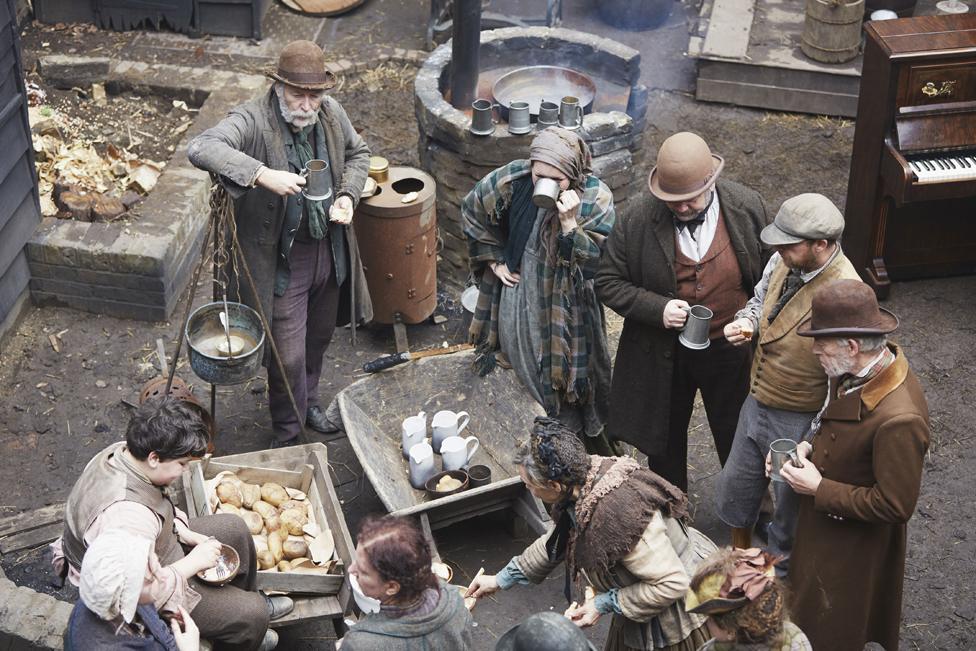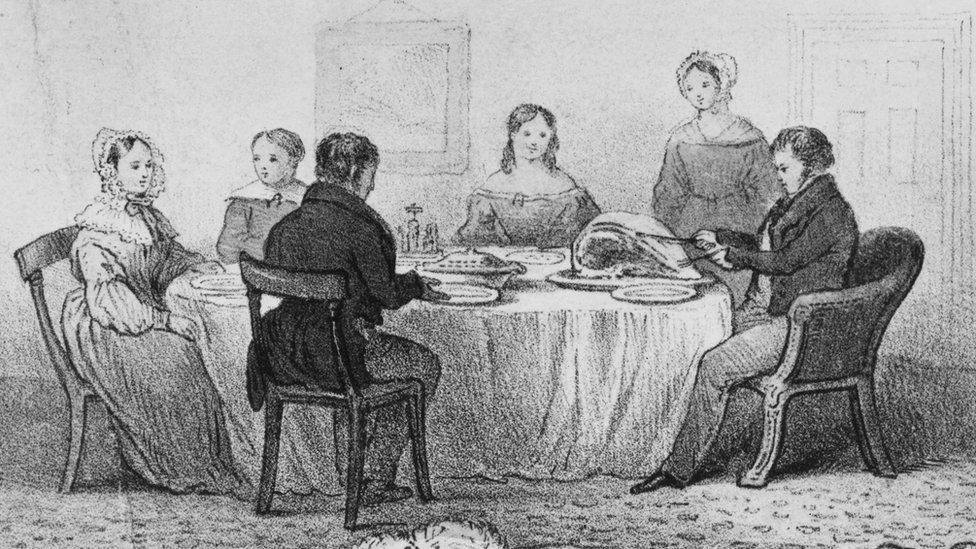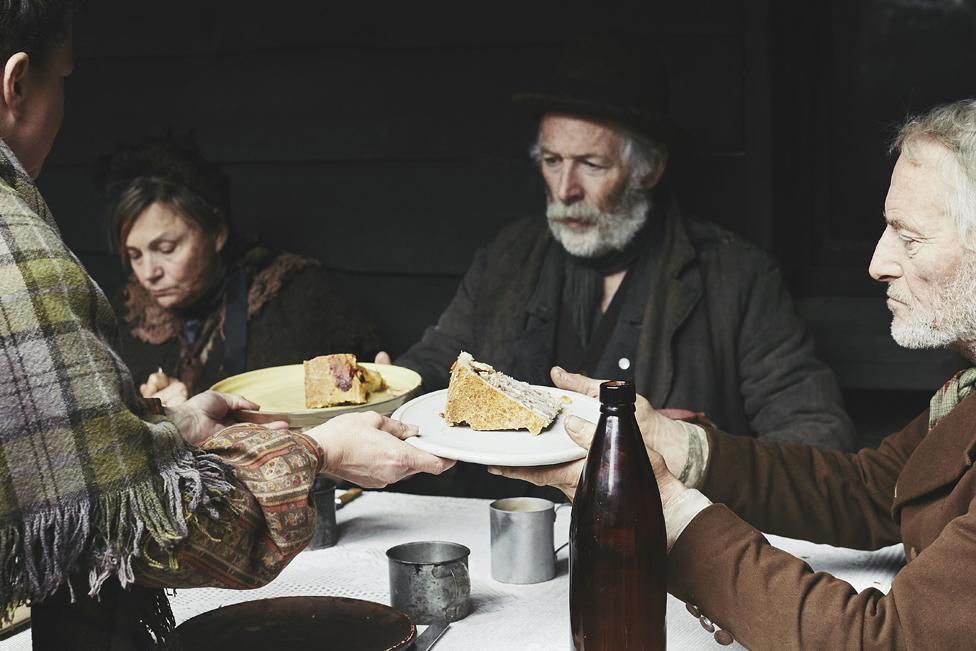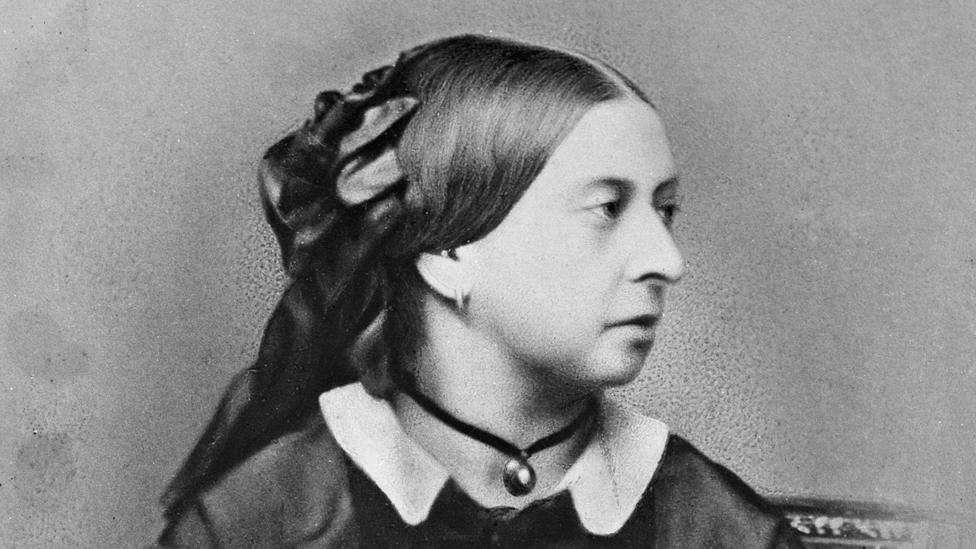How to eat like a Victorian
- Published

Although Victorians faced many public health problems, could it be that they ate more healthily than us? Michael Mosley investigates.
Many of us like the fantasy of being a time traveller, popping back to see how people out of our history books really lived. Over the last few months I've been making a series in which a group of volunteers have experienced for themselves something of what their ancestors had to endure, by living in a reconstructed Victorian slum.
Although they had a tough time, none of our volunteers had to put up with the wide range of lethal microbes that killed so many in London's East End in the mid-Victorian period. Nor was their food quite as unpalatable as it would have been then, though they were often hungry.
In Victorian times few slum dwellers would have had ovens or cooking utensils. Many didn't even own plates or spoons. They lived mainly on bread, gruel and broth (made from boiling up bones). Not surprisingly, the children of the slums were undernourished, anaemic, rickety and very short.

A study which compared the different heights of Victorian youths, based on their class and their income - On British Pygmies and Giants - makes particularly shocking reading, external. The study found that young recruits to the Royal Military Academy Sandhurst, who came largely from a middle or upper class background, were amongst the tallest young men in the world at that time, averaging almost 175cm (5ft 9in)
Find us on Facebook , external
By contrast, 16-year-old boys from the slums who were recruited by the Marine Society, a charity set up to provide the Navy with a regular supply of manpower, were 22cm (8.6in) shorter.
If you were not at the bottom of the heap, then things were quite a lot better. In some ways Victorians had a healthier diet than we do now because they ate much more nutrient-rich food and consumed far less sugar and processed food.

Find out more

Michael Mosley presents The Victorian Slum on BBC Two on Mondays at 21:00 BST - catch up on BBC iPlayer

A typical breakfast might consist of stoneground bread smeared with dripping or lard (consisting largely of healthy monounsaturated fats), accompanied by a large bunch of watercress, rich in vitamins, minerals and phytonutrients.
There were plenty of cheap, seasonal vegetables to be found in the markets, including onions, cabbage, leeks, carrots and turnips. The main fruits were apples in the winter and cherries in the summer.
The Victorians also ate lots of healthy, fibre-rich nuts, such as chestnuts and hazelnuts, which were often roasted and bought from street-corner sellers.
Meat was relatively expensive, though you could buy a sheep's head for about 3d (£2.50 in modern money). Instead they ate plenty of omega-3-rich oily fish and seafood. Herrings, sprats, eels, oysters, mussels, cockles and whelks, were all popular, as were cod and haddock.

A shellfish stall in Victorian London
According to a study published in the Royal Society of Medicine, "How the Mid-Victorians Worked, Ate and Died", external, the combination of enormous amounts of physical activity (most people did physically demanding jobs which meant they were active for 50 to 60 hours a week) and a diet rich in fruits, whole grains, oily fish and vegetables meant that Victorians suffered less from chronic, degenerative diseases than we do.
Dr Paul Clayton, one of the authors of the study, claims that they were "90% less likely to develop cancer, dementia and coronary artery disease than we are today". It certainly meant that diseases like type-2 diabetes, which plague modern society, were vanishingly rare.

The low-carb Victorian diet
Although they ate far more calories than we do, because they were so active, obese Victorians were relatively rare. William Banting, a Victorian undertaker, was an exception. He was apparently so fat he had to go down the stairs backwards. His family were funeral directors to the Royal Household and oversaw the funerals of the Duke of Wellington, Prince Albert and Queen Victoria herself.
William Banting, however, is chiefly famous for being the first person to popularise a low-carb diet. In a booklet he self-published in 1863, A Letter on Corpulence, he describes how he lost over 40lb (18kg) in just a few months by cutting out foods such as bread, sugar, beer and potatoes. Despite a contemptuous response from the medical profession, his modest booklet went on to become a bestseller and "to bant" became a popular term for dieting. One of Banting's descendants, Sir Frederick Banting, would later win the Nobel Prize for pioneering the use of insulin in the treatment of diabetes.
Other Victorian Innovations include:
The modern breakfast
In the early years of the Victorian era breakfast would have consisted, if you could afford it, of cold meats, cheese and beer. In time this was replaced by porridge, fish, eggs and bacon - the "full English". By the end of the 19th Century, however, this relatively healthy start to the day was being challenged by manufacturers of sugary breakfast cereals, pioneered by people like Dr John Harvey Kellogg.
Dr Kellogg, who had strange views about sex and eugenics, is said to have invented Corn Flakes as part of his health regimen to prevent masturbation, a subject he was absolutely obsessed by. He was convinced that replacing meat and eggs with bland foods, like corn flakes, would reduce excitement and arousal in young men. He also recommended a daily enema. Of yoghurt.

The Sunday lunch
For many Victorians Sunday was the only day of rest they would get (a 12-hour day, six days a week was common). It was also the only day when they would eat meat. So began the custom of buying a small joint of beef, pork or mutton to be shared with the family, accompanied by lots of vegetables, potatoes and gravy. If you couldn't afford a roast joint then there was always offal, such as liver, tongue or heart.
The three-course dinner

Queen Victoria - a glutton and a fast eater
The Victorian era saw the introduction of two or three-course meals, with the courses arriving in sequence, one at a time. Before that the courses all tended to arrive at once. Queen Victoria, who was something of a glutton, was able to put away seven courses in less than half an hour. Since everyone was served after the Queen, and when she had finished all the plates were cleared, there was a good chance you would be leaving one of her magnificent banquets very hungry.
Join the conversation - find us on Facebook, external, Instagram, external, Snapchat , externaland Twitter, external